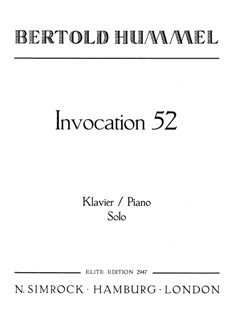Invocation52 for piano solo op. 7 (1952)

First performance: March 1969, Bratislava, Broadcast
Peter Roggenkamp
Duration: 5 Minutes
Publisher: N. Simrock Hamburg-London (Boosey & Hawkes) EE 2947 / ISMN M-2211-0848-7
The
piano piece Invocation52, op. 7 was my first compositional - and
somewhat individual - involvement with the serial technique of Arnold Schönberg.
Bitonal chords, forming sounds containing the complete chromatic material, appear
alongside their linear resolutions, in each case supported by held notes and in
rhythmic variation. The formal framework is supplied by two "invocations",
based on identical musical material, ending both times on the note e-flat, fading
at the end in ppp.
Bertold
Hummel
Here
there are hardly any fixed structures anymore, the whole piece is constantly dissolved
in linear quasi-arabesques of melting contours, rhetorical in its whole essence.
"Invocation" means appeal or conjuring-up. This music lives entirely
on the strength of an experience in sonority, has a nothing less than magical
effect. Compared with the sonority, the structure has only secondary significance.
And yet, there is even in this music a component which betrays - as so often in
Hummel - the mathematician: after 10 rhapsodic introductory bars, a four-bar idea
follows, in which six notes are assembled in layers of thirds to form columns
of major or minor chords, thus exemplifying Zarlino's dual principle (bars
10-14). After these four bars, 24 bars of free rhapsody follow, which, despite
their loosely worked texture, create the formal framework. Remarkably in all this,
the fermata at the end of the four bars described above is placed more or less
precisely at the "sectio aurea "!
Klaus Hinrich Stahmer (in "Die Kammermusik als persönliches Bekenntnis", Tutzing, 1998)
